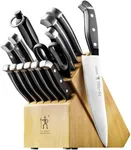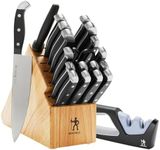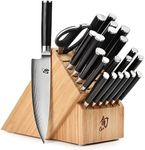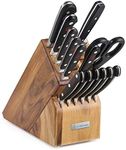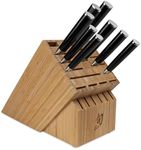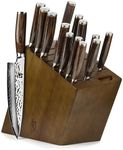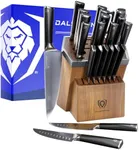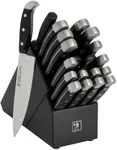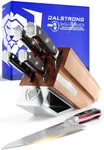Buying Guide for the Best Knife Sets
Choosing the right knife set is an important step in setting up your kitchen for efficient and enjoyable cooking. A good knife set will provide you with the specific tools needed for everyday food prep, from slicing vegetables to carving meats. The goal is to find a set that covers your culinary needs, feels comfortable in your hand, and will last with proper care. It’s also good to consider ease of maintenance and how much space you have for storage when picking a set.Blade MaterialBlade material is what the knife’s cutting part is made from and it directly affects the knife’s sharpness, durability, and ease of maintenance. The most common materials are stainless steel, high-carbon steel, and ceramic. Stainless steel is rust-resistant and easy to care for, making it a popular choice for most kitchens. High-carbon steel holds a sharp edge longer but can be more prone to rust if not maintained properly. Ceramic blades stay sharp for a long time and resist staining, but can chip or break if dropped. When picking a blade material, think about your willingness to maintain the knives and how often you’ll use them.
Handle Design and ComfortThe handle is where you grip the knife, and it hugely influences comfort, control, and safety while cutting. Handles can be made from wood, plastic, or composite materials. Wood handles have a traditional feel but need more care to prevent damage from water. Plastic and composite handles are more resistant to moisture and easier to clean. The shape of the handle matters too—choose a handle that fits comfortably in your hand and offers a secure grip. If you have smaller or larger hands, be sure to pick a set that feels comfortable for you during repeated use.
Included KnivesKnife sets come with a variety of pieces, usually including a chef’s knife, paring knife, bread knife, and others like utility or serrated knives. Some sets have more speciality knives, while others stick to just the basics. Consider what kind of cooking you do most often; if you mostly do general cooking, a few basic knives will suffice, but if you like baking or preparing exotic dishes, a set with specialty blades might be helpful. Avoid buying sets with lots of knives you won’t actually use.
Sharpness and Edge RetentionSharpness refers to how finely the knife can cut, and edge retention is how long it stays sharp before needing to be honed or sharpened again. This depends mostly on the blade’s material and design. Knives that stay sharp longer require less upkeep but can be harder to sharpen on your own. If you don’t want to sharpen knives often, look for a set known for edge retention. If you’re comfortable sharpening, you might prioritize knives that are easy to hone regularly.
Balance and WeightBalance and weight describe how the knife feels in your hand and how easily you can control it. A balanced knife is neither blade- nor handle-heavy, and should feel natural to maneuver. Weight is a personal preference—some people like heavier knives for chopping, while others prefer lighter ones for delicate tasks. Think about what feels comfortable for your wrist and hand strength, and choose a set with knives that won’t tire you out during prep.
Maintenance and CareMaintenance and care refer to how easy the knives are to clean, sharpen, and store. Some knives are dishwasher safe, but hand washing is usually best to preserve sharpness and prevent corrosion. Consider whether the set comes with a storage block, magnetic strip, or protective sheaths, as this helps keep knives safe and handy. If you want the least upkeep, pick knives that resist staining and rust, and avoid wood handles if you'll be washing them often.
